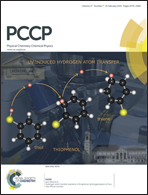A model study on the photochemical isomerization of cyclic silenes†
Abstract
The mechanism for the photochemical isomerization reaction is investigated theoretically using a model system of a five-membered-ring silene and the CAS(8,8)/6-311G(d) and MP2-CAS-(8,8)/6-311++G(3df,3pd)//CAS(8,8)/6-311G(d) methods. These model investigations indicate that the preferred reaction route for a five-membered-ring silene, which leads to the photorearrangement product, is as follows: reactant → Franck–Condon region → conical intersection→ photoproduct. In other words, the direct mechanism is a one-step process that has no barrier. These theoretical results agree with the available experimental observations.


 Please wait while we load your content...
Please wait while we load your content...